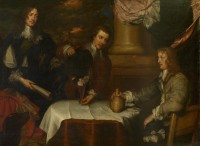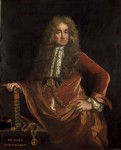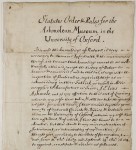 The Ashmolean Museum has acquired an exceptional group painting by Civil War-era court painter William Dobson. It was acquired through the Acceptance in Lieu scheme, which allows donation of nationally significant artworks and antiquities in place of payment of taxes owing, and allocated to the Ashmolean because of the painting’s unique relevance to Oxford during the Civil War.
The Ashmolean Museum has acquired an exceptional group painting by Civil War-era court painter William Dobson. It was acquired through the Acceptance in Lieu scheme, which allows donation of nationally significant artworks and antiquities in place of payment of taxes owing, and allocated to the Ashmolean because of the painting’s unique relevance to Oxford during the Civil War.
The work was commissioned by Colonel John Russell, commander of Prince Rupert’s elite Bluecoats regiment, in the winter of 1645–6, less than a year before Dobson’s death. The painting captures three of the Royalist commanders: Prince Rupert, King Charles I’s nephew, Colonel William Legge, the Governor of Oxford, and John Russell. This was a tough time for the three men and for the Royalist cause in general. Rupert, the figure on the left, had just been defeated at Bristol, surrendering the main Royalist port to the Parliamentarians. John Russell, a supporter of Rupert’s who had valiantly fought at the Battle of Naseby and barely survived to fight again at Bristol, is on the right. Legge stands in the center.
The painting is filled with symbols and references to the recent discord between the King and his nephew and to Rupert’s enduring loyalty. The scroll which Rupert holds in his right hand may refer to the blank sheet which Charles had sent to him on which to compose his confession. Instead, being innocent, Rupert asked Legge to return the letter empty, which greatly moved the King and resulted in a pardon. Rupert has also discarded his scarlet cloak which he was recorded as wearing when he rode out of Bristol following his surrender.
Beside the cloak is a dog wearing a collar with the initials ‘P.R.’ The dog is a motif traditionally associated with faithfulness and may, in this painting, be intended to stand for Boye, Rupert’s famed white poodle who rode into battle with the Prince and was killed in 1644 at Marston Moor. To Parliamentarian pamphleteers Boye was a ‘devil dog’ credited with supernatural powers, such as being weapon-proof and able to catch bullets with his teeth. Among Royalists, Boye was also immensely popular and as ‘Sergeant-Major-General Boy’, he became the army’s mascot. There is also, in the painting, hints of revenge likely to be directed towards George Digby, 2nd Earl of Bristol, who led the faction against Rupert and tried to convince the King that his nephew was a traitor. The central figure dips his cockade in the glass of wine which evokes biblical episodes where clothing stained with wine symbolized vengeance.
Oxford became the new Royalist capital in 1642 after Parliamentarians took London and King Charles I fled. There he established his court in exile where it remained until the city was successfully besieged by Parliamentarian forces in 1646 and Charles escaped yet again, this time disguised as a servant.
 Elias Ashmole was a staunch Royalist. He left London in 1642 too, and moved to Oxford in 1644 where he was appointed an ordnance officer for the King’s army. A lawyer by trade, Ashmole was a man of eclectic interests including alchemy, botany, astronomy and collecting antiques, coins and books. He took full advantage of the opportunities his new town had to offer. In 1645 he was accepted to Brasenose College where he would pursue his studies in natural philosophy, mathematics, astronomy and astrology.
Elias Ashmole was a staunch Royalist. He left London in 1642 too, and moved to Oxford in 1644 where he was appointed an ordnance officer for the King’s army. A lawyer by trade, Ashmole was a man of eclectic interests including alchemy, botany, astronomy and collecting antiques, coins and books. He took full advantage of the opportunities his new town had to offer. In 1645 he was accepted to Brasenose College where he would pursue his studies in natural philosophy, mathematics, astronomy and astrology.
Long after the Civil War was over and just a year before the Restoration, Ashmole’s renowned collection of coins, book and manuscripts was geometrically expanded when John Tradescant the Younger, who like his father was a famed gardener (they’re both buried in the St. Mary-at-Lambeth churchyard) and collector of varied treasures from books and coins to weapons, taxidermied animals and curiosities of natural science, either gave his collection to Ashmole or was conned out of it by Ashmole in 1659.
 The Ashmole-Tradescant collection was bequeathed to Oxford by Ashmole in 1677. In 1683 he had the whole kit and caboodle moved to a new museum on Broad Street custom-built to house the treasures. The collection was by then so large that it filled 26 great chests and had to be moved to the museum by barge. Unlike its predecessors, which were either private holdings or used for institutional research and teaching, the original Ashmolean was the first modern public museum, forming the blueprint for museums as we know them today. That first Ashmolean building on Broad Street still stands, now as the Museum of the History of Science.
The Ashmole-Tradescant collection was bequeathed to Oxford by Ashmole in 1677. In 1683 he had the whole kit and caboodle moved to a new museum on Broad Street custom-built to house the treasures. The collection was by then so large that it filled 26 great chests and had to be moved to the museum by barge. Unlike its predecessors, which were either private holdings or used for institutional research and teaching, the original Ashmolean was the first modern public museum, forming the blueprint for museums as we know them today. That first Ashmolean building on Broad Street still stands, now as the Museum of the History of Science.
Friday, May 19th, is the 400th anniversary of Elias Ashmole’s birthday. The Ashmolean will be celebrating their founder’s 400th birthday with a grand parade down Broad Street by Civil War reenactors. King Charles I will lead the procession at the head of his army. When they reach the Ashmolean, they will join Elias Ashmole’s birthday party where reenactors will bring to life the characters in his 400th birthday present painting.
I always find it amusing how the words Civil War mean completely different things to Americans and the British 🙂
I’m like … ‘Court painter?’ and then ‘Oh, *that* Civil War!’ LOL
Whilst Oxford may celebrate Charles 1 in truth it owes far more to the moderation of the Commander of the Parliamentary forces …”Whilst, however, the whole military authority was in appearance devolved on Lord Fairfax, it was, through the machinations of the Independents, really exercised by Cromwell. Fairfax was in truth too good and honest a man for the party to which he was attached. His moderation in the hour of triumph was remarkable; and on the surrender of Oxford, he was particularly careful to preserve the Bodleian Library and other places, from pillage; and it has been said that through his influence, the University suffered less from the Parliamentary troops, than it had done from those of the Royalists.”
This is similarily true of York where this man alone saved over half the medieval stsined glass in England from destruction
“One measly Civil War in the entire history of England, and I am on the wrong Bloody side !” – (Ed Blackadder) 😆
———-
Immediately, I wondered what the central figure might be doing to what appears to be a glass of beer. Apart from ‘biblical episodes’, does this action allude to anything else ? If the painting was commissioned by the person sitting on the right (Royalist John Russel) after the fall of Oxford, partially with William Legge, the vengeance bit was later put into action.
Of even more interest, however, seems to be Prince Rupert of the Rhine, who was, born in Prague into the House of Wittelsbach, fighting against Spain in the Netherlands, against the Holy Roman Emperor in Germany during the 30y War, and was indeed appointed commander of the Royalist cavalry during the English Civil War.
Then, under Louis XIV of France, he fought Spain and privateered in the Caribbean. After the Anglo-Dutch wars, engaging in scientific invention and arts, and serving as the first governor of the Hudson’s Bay Company, he played a role in the early African slave trade. Later, he became a founding member of the Royal Society and he pursued studies in natural sciences himself.
Central European ‘student fraternities’ wear ‘Couleur’, of which ‘Zipf’ or ‘Zipfel’ (cf. ‘tip’, ‘timpe’) losely resemble a ribbon-like cockade, to this day.
They come into play to (playfully) pledge alliances, but also allegations, and they also play an important role in student beer drinking games.
They might, however, have a common, even more militaristic tradition in those, much older days of 17th century Central European civil wars.
Unfortunately, I have -almost- no source for this conjecture:
————–
Much Ado About Nothing, Act V: “I thinke he thinkes vpon the sauage bull: Tush, feare not man, wee’ll tip thy hornes with gold, And all Europa shall reioyce at thee …”.
“Hat-tippings and cap-doffings are of course of a different nature to more elaborate verbal greetings.”
“Manntje, Manntje, Timpe Te, Buttje, Buttje in der See, myne Fru de Ilsebill will nich so, as ik wol will !”, and the fish greets back with “Manntje, Manntje, Timpe Te!” (The Fisherman and His Wife).
Boye, devil dog and war poodle. Great blog! Always something to fold up and save to my archive of peculiar facts. :hattip:
For just plain aesthetics, I love the composition of this painting. The eye is led down diagonally through the eye contact of the subjects and back along the bottom to the dog who is fixed on the central character, who appears to be vowing revenge, and the black hat is reminiscent of the black spot on the palm of a pirate condemned by his colleagues, an omen of death. Superb story-telling in the painting and in the history, too. I love your blog!
A grand parade down the Broad during the examination season? Madness. Surely somewhere an examination hall’s worth of snowflakes will complain of the din outside?